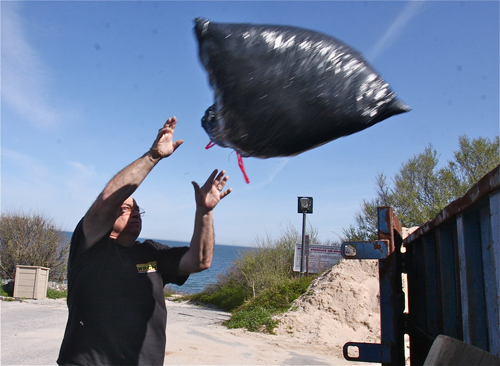
The Brookhaven landfill is rapidly approaching the end of its life. It’s long overdue — for decades, the 270-foot-tall dump has poisoned the South Shore of Long Island. Sitting in the heart of a predominantly Black and Latino neighborhood with the lowest life expectancy on Long Island and the second-highest rates of asthma in Suffolk County, the closure of this behemoth should be cause for celebration.
But that’s getting lost in the scramble to figure out where to dump our trash next. It just goes to show how skewed our priorities are. Rather than taking the opportunity to think critically about reducing our waste production or investing in more sustainable waste management practices, we’re scoping out which community we can poison with our trash instead.
If not Long Island, that waste is going to destroy communities elsewhere. More than likely, it’ll be hauled to my neck of the woods, to pile on to the state’s largest dump, Seneca Meadows, located in the heart of the Finger Lakes region in Seneca Falls. It’s time for New York to get serious about our trouble with trash.
Brookhaven is just one of 25 landfills across the state. Landfilling is an unsustainable practice — space fills up fast, and it won’t be long until these landfills are at capacity and shut down. We need a new plan. We can’t keep finding new corners of the state to bury in trash. New York must take this opportunity to enforce sustainable waste management and waste reduction strategies at scale.
Don’t get me wrong — I’m incredibly excited that the tens of thousands of people that have been harmed by the landfill on Long Island and beyond will get the relief that they deserve. New Yorkers that live in the shadow of the Brookhaven landfill know better than anyone the huge toll a dump has on quality of life. The odor is pervasive, the truck traffic is unbearable, and the health and environmental impacts are extremely detrimental. Neighboring residents have filed a handful of lawsuits against the landfill, which accepts toxic waste, citing the town’s failure to protect residents against toxins from the landfill resulting in cancer and other illnesses.
Unfortunately, it’s a story I’m all too familiar with. In Seneca Falls, I’m leading a statewide fight to permanently close the Seneca Meadows landfill. After nearly 40 years of poisoning the region, Seneca Meadows will be reaching its capacity this year, but its for-profit, Texas-based operator applied for a permit to not only extend its operations for another 15 years but grow its massive footprint. Seneca Meadows emits huge quantities of greenhouse gases, releases “forever chemicals” like PFAS, which are known to cause serious health issues such as cancer and reduced ability of the body’s immune system to fight infection, into waterways across New York, and releases a persistent, foul odor that makes residents sick.
Seneca Meadows is facing mounting opposition from elected officials and community and business leaders from across the state. It couldn’t be more clear that New Yorkers have had enough — now it’s up to the state to decide our fate. Are we accepting the business-as-usual and 15 more years of pollution, or are we moving forward towards a cleaner and more sustainable future for New York?
Late last year, the Department of Environmental Conservation released the New York State Solid Waste Management Plan, which maps out a strategy to prioritize more sustainable waste management practices and emphasizes reducing the amount of waste sent to landfills, making dumps a last resort. Increasing our landfilling capacity completely contradicts these goals.
Shutting down a landfill that is at capacity is complicated and costly. But it also signals a major, long-term investment in air and water quality, health and well-being and the environment, all while keeping New York on track to meet its environmental goals. The closure of the Brookhaven landfill has already been delayed in favor of a phased closing that will run through 2027 or 2028. While the biggest question on local officials’ minds is where to haul off their waste once Brookhaven finally shutters, it’s more important than ever to advocate for robust investments in recycling and composting programs and adopt legislation that enforces producer responsibility and supports reusable and refillable products over single-use products.
From Long Island to the Finger Lakes, New Yorkers are victims of our own throwaway culture. It’s time to move away from landfilling and poisoning our communities to usher in a zero-waste future.
Yvonne Taylor is the co-founder and vice president of the not-for-profit conservation group Seneca Lake Guardian.

